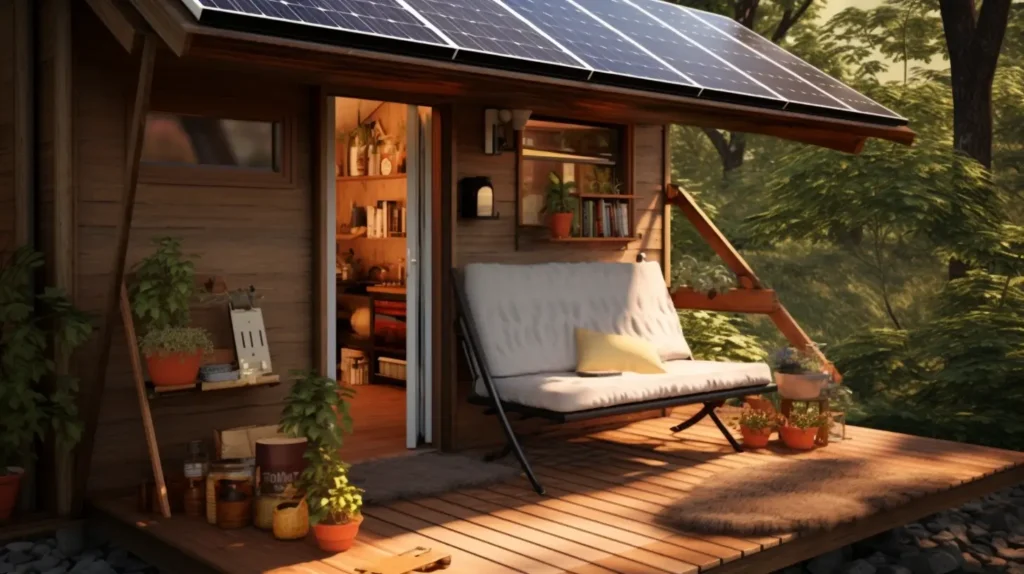So, you’ve taken the plunge into the wonderful world of tiny living. Your house might be small, but your dreams are big. Yet, it’s not all rainbows and sunshine. The financial side of tiny house living can be a bit like a tightrope walk without a safety net. But fear not, my fellow tiny house enthusiast, for I’m here to be your financial sherpa in this thrilling journey. Here are six tiny house financial literacy resources tips you may find very helpful!
Budgeting Basics: The Roadmap to Financial Bliss
Budgeting might sound about as fun as a rainy day during your camping trip, but trust me, it’s your tiny house’s secret weapon for financial success. Picture this: you’re building your tiny house without a blueprint. Chaos, right? Your financial future is no different. Budgeting is your roadmap to financial bliss, guiding you through the twists and turns of tiny living.
So, how do you create a budget that feels less like a straitjacket and more like a trustworthy GPS system? Start by taking a good look at your monthly expenses. What’s coming in, and what’s going out? It’s like knowing how much gas you need for your cross-country road trip – you wouldn’t leave it to chance.
Once you’ve got your expenses nailed down, set some goals. How much do you want to save? What’s your monthly allowance for fun stuff? Think of these goals as the pit stops along your financial journey. They’re what keep you motivated and on the right path.
Remember, a budget isn’t there to make you feel deprived; it’s your financial co-pilot, helping you navigate the scenic route to your tiny house dreams.
The Art of Saving: Stash That Cash
Saving money can feel like trying to catch fireflies on a warm summer night – elusive, but oh so magical when you catch them. In the world of tiny house living, saving money is your jar full of glowing fireflies, illuminating your path to financial freedom.
But how do you start? It’s all about mastering the art of saving. First, get cozy with your budget, as we discussed earlier. Identify those areas where you can trim down, like cutting back on that daily latte or finding thriftier ways to furnish your tiny haven. Every penny saved is another firefly in your jar.
Now, it’s time to put those fireflies to work. Consider opening a dedicated savings account – call it your “Tiny Treasure Chest.” Treat it like a sacred vessel, where you deposit your fireflies regularly. Watch your treasure grow, and revel in the satisfaction of knowing you’re one step closer to your tiny house dreams.
Remember, saving money isn’t about deprivation; it’s about prioritization. It’s about choosing what truly matters to you and allocating your resources accordingly.
Debunking Debt: The Monster Under the Bed
Debt – it’s the lurking monster that can haunt your financial dreams, especially in the world of tiny house living. But guess what? We’re here to debunk the myths and chase that monster from under the bed!
First things first, understanding your debt is like shining a flashlight on that mysterious creature. List all your debts, big and small, from student loans to credit card balances. Once you see them clearly, you can conquer them.
Next, create a battle plan. Prioritize your debts, focusing on high-interest ones first. It’s like taking out the monsters closest to you before tackling the ones in the dark corners of your room. Pay more than the minimum whenever possible – it’s your sword and shield in this battle.
Now, let’s talk about the importance of an emergency fund. It’s your safety net, your secret weapon against unexpected expenses that might summon the debt monster back. Aim for at least three months’ worth of living expenses.
Remember, tiny house living is about financial freedom, and debt is the anchor that can weigh you down.
Building Credit: Your Financial Passport
Ah, credit – the golden ticket to financial opportunities, and yes, even in the tiny house world. It’s like having a passport to the land of financial freedom. Let’s dive into the art of building credit.
Think of your credit score as your reputation in the financial realm. To start building it, you’ll need to establish credit. This is where small steps come into play. Get a credit card, but use it wisely. It’s like dipping your toes in the water before taking the plunge.
Now, let’s talk about payment history. Pay your bills on time, every time. It’s like showing up for work – you wouldn’t want to be late or absent. This is a significant factor in building good credit.
Credit utilization is next. Keep your credit card balances low. It’s like not maxing out your budget on a shopping spree. High balances relative to your credit limit can harm your score.
Credit mix matters too. Having a mix of credit types, like credit cards, loans, and mortgages, can boost your score. It’s like having a diverse set of skills in your toolkit.
Lastly, don’t open too many new credit accounts at once. It can make you seem risky to lenders. Remember, building credit is like constructing a tiny house – it takes time and careful planning. As your credit score rises, doors open – better loan rates, more opportunities.
Investing for the Future: Planting Money Trees
Now, let’s get to the juicy part – investing. Picture it: you’re planting seeds today, and in the future, you’ll have a lush money tree providing shade and sweet, sweet fruits. Investing is your green thumb in the world of finance.
But where to begin? Well, it’s like choosing the right soil for your tree. You need a solid foundation. Start with an emergency fund – it’s your financial compost, providing essential nutrients for growth.
Now, consider retirement accounts. A 401(k) or an IRA is like a specially designed greenhouse for your money tree. You contribute a portion of your income, and it grows tax-free until retirement. Employers may even match your contributions – free fertilizer!
Stocks and bonds are like different species of money trees. Stocks are your risk-takers, like planting a fruit tree that might have some stormy seasons but yields abundant harvests. Bonds are more like planting a sturdy oak tree – steady and reliable.
Diversify your investments – it’s like having an orchard of various trees. If one doesn’t do well, others can compensate. And don’t forget to nurture your portfolio by rebalancing periodically. It’s like pruning and tending to your garden.
Remember, patience is key in investing. It’s like watching your sapling grow into a towering oak. Small contributions over time can lead to significant financial growth.
Educate Yourself: The Key to Financial Freedom
Imagine you’re embarking on a treasure hunt, and the treasure is financial freedom. To find it, you need the ultimate tool – knowledge. Financial education is your trusty map, guiding you through the twists and turns of the money maze.
Why is financial education so crucial? Well, think of it as the compass that keeps you on the right path. It empowers you to make informed decisions, avoid pitfalls, and seize opportunities.
Start by understanding the basics. Learn about budgeting – your financial roadmap. It’s like having GPS for your money, ensuring you reach your destination without running out of fuel.
Next, explore the world of saving and investing. It’s like discovering hidden treasure chests along your journey. Knowing how to make your money work for you is a game-changer.
Debunking financial myths is like slaying dragons on your quest. Don’t let misinformation or misconceptions block your path to success. Arm yourself with facts and logic.
Building good financial habits is like forging armor to protect your wealth. Discipline in spending, saving, and investing is your shield against financial storms.
Continuously educate yourself about personal finance – it’s like leveling up in the game of life. Attend seminars, read books, or follow reliable financial blogs. In the end, your financial education is the key that unlocks the door to financial freedom. It’s the lantern that lights your way through the darkest financial tunnels.
Conclusion: Tiny House Financial Literacy Resources
Tiny house living is about more than just downsizing; it’s about simplifying your life, reducing stress, and pursuing your dreams. But to achieve all this, you need to be financially savvy. Start today, build your financial fortress, and live your tiny house dream to the fullest.
Now, my tiny house comrades, share this wisdom with the world. Click those share buttons, let your friends in on the secret, and let’s all embark on this financial journey together.


